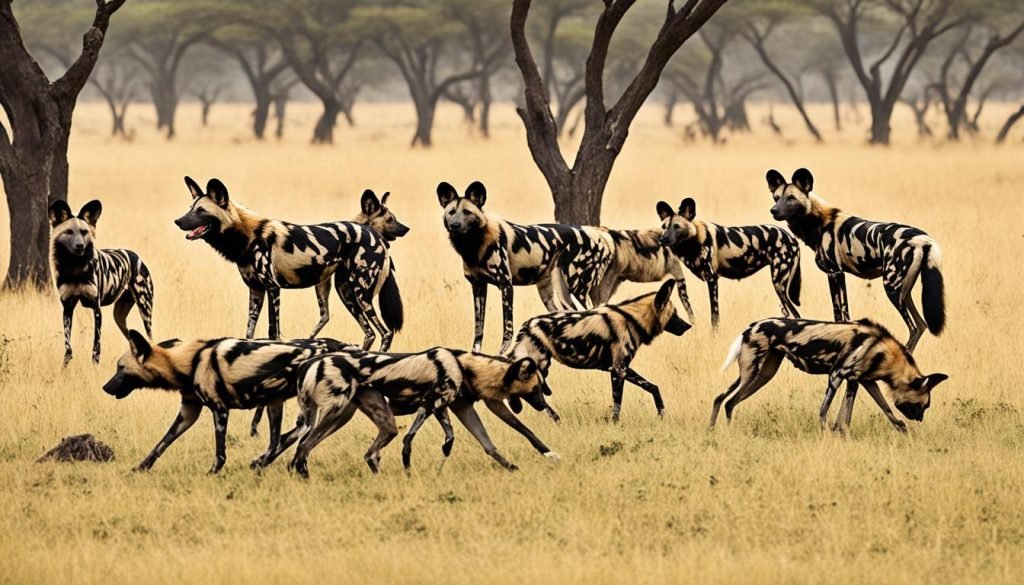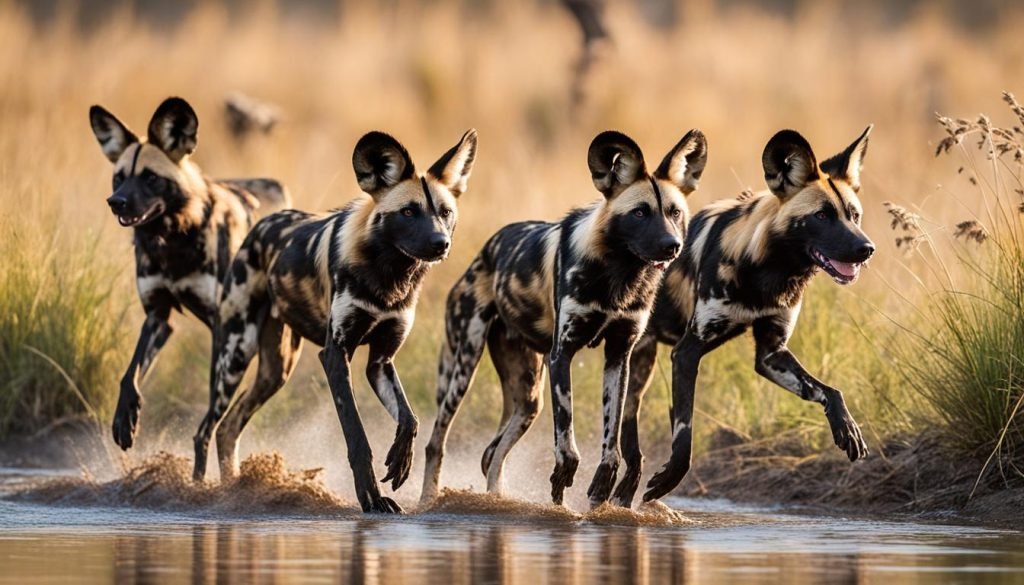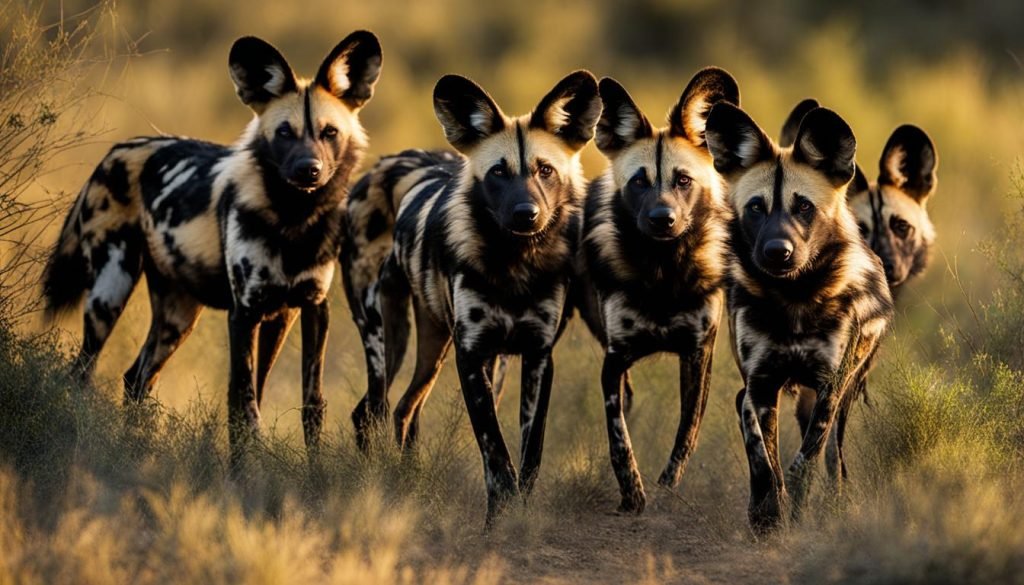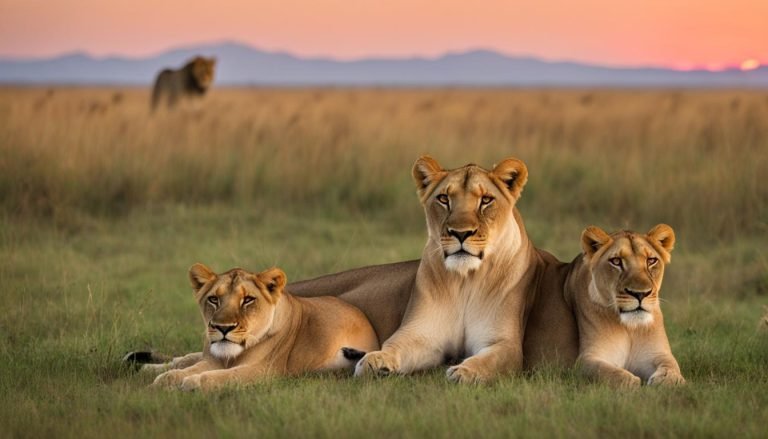Habitats Explored: Where Do African Wild Dogs Live?
Wild dogs, also known as African wild dogs, are fascinating creatures that inhabit specific habitats across sub-Saharan Africa. In this article, we will explore the natural habitat and geographical distribution of wild dogs, shedding light on their living environment and range.
Key Takeaways:
- Wild dogs, or African wild dogs, are found in sub-Saharan Africa.
- Their largest populations can be found in countries like Botswana, Zimbabwe, Namibia, Zambia, Tanzania, and Mozambique.
- They prefer open plains and sparse woodlands as their habitat.
- Human activities and habitat fragmentation have led to a reduction in their natural habitat.
- Conservation efforts are being made to protect the endangered wild dog population.
Where do African Wild Dogs Live? Their Habitat

African wild dogs, also known as Cape hunting dogs or painted dogs, have a diverse geographical distribution. They are primarily found in the African savannas and forests of Asia. However, their habitat has been significantly reduced over the years due to human activities and habitat fragmentation.
These fascinating creatures prefer habitats that provide them with the conditions they need for survival. They thrive in areas with open plains, savannas, and sparse woodlands, where they can hunt their prey and find shelter.
“African wild dogs are highly adaptive and have been observed in a variety of ecosystems, from grasslands to dense forests. However, their population density is highest in the African savannas, where they can follow the herds of their preferred prey.” – Dr. Jane Wilson, Wildlife Biologist
Due to their unique habitat requirements, African wild dogs face significant challenges. As human populations expand and encroach upon their territories, the availability of suitable habitats diminishes. This, in turn, puts additional pressure on the already vulnerable populations of these remarkable creatures.
Conservation efforts are crucial in protecting the remaining African wild dog habitat and ensuring the long-term survival of this endangered species.
Geographical Distribution of African Wild Dogs
While African wild dogs are primarily found in sub-Saharan Africa, their distribution spans across several countries. The largest populations of African wild dogs can be found in Botswana, Zimbabwe, Namibia, Zambia, Tanzania, and Mozambique.
Table: African Wild Dogs’ Geographical Distribution in Sub-Saharan Africa
| Country | Population Size |
|---|---|
| Botswana | 2,500 |
| Zimbabwe | 1,500 |
| Namibia | 1,000 |
| Zambia | 900 |
| Tanzania | 600 |
| Mozambique | 400 |
Physical Characteristics of African Wild Dogs

African wild dogs, also known as the Cape hunting dog or painted dog, possess unique physical traits that set them apart from other canines. These endangered creatures exhibit distinct sizes, weights, and appearances.
Size and Weight
African wild dogs are medium-sized canines, measuring between 29.5 to 43 inches in length from the tip of their nose to the end of their tail. They typically weigh between 39.5 to 79 pounds, showcasing their agile and lean bodies.
Coat and Appearance
The African wild dog boasts a striking and colorful coat pattern, characterized by patches of red, black, brown, white, and yellow fur. Each dog’s coat is unique, featuring its own distinctive pattern, allowing for individual identification within a pack. This mottled coat serves as effective camouflage while hunting in the savannas and woodlands of Africa.
In addition to their captivating coat, African wild dogs possess big, rounded ears that provide excellent hearing capabilities. Their ears are not only prominent physical features but also help regulate body temperature by dissipating heat in the hot African climate.
While offering a visually stunning appearance, the unique size, weight, and coat of African wild dogs serve vital functions in their survival and adaptation to the African wilderness.
Pack Behavior and Hunting Strategies

African wild dogs are highly social animals that live in packs. These packs are usually dominated by a monogamous breeding pair, consisting of an alpha male and an alpha female. The rest of the pack members are their offspring from previous litters or unrelated individuals who joined the pack.
Unlike other predators, African wild dogs do not rely on a hierarchical pack structure. Instead, they work as a cooperative unit, with every member playing a crucial role in the survival and success of the pack.
Communication within the pack is essential for their coordination during hunting and other activities. African wild dogs use touch, various actions, and vocalizations to convey information and maintain group cohesion. Their unique vocalizations, such as high-pitched squeaks and chirps, help the pack members stay in contact with each other during hunts and when separated.
When it comes to hunting, African wild dogs have developed efficient strategies that maximize their chances of success. They are endurance hunters, and their teamwork and coordination play a crucial role in capturing their prey.
During a hunt, the pack aligns itself in a V-shaped formation and starts pursuing their target. They maintain a fast pace, often reaching speeds of 37 miles per hour and covering long distances. By working together, they can exhaust their prey, which often includes antelopes like impalas, kudus, and gazelles, as well as larger animals like wildebeests.
African wild dogs are opportunistic hunters and adapt to the presence of potential prey. They adjust their hunting strategies based on the size of the pack and the available opportunities in their habitat.
Here is a table summarizing the key characteristics of African wild dog pack behavior and hunting strategies:
| Behavior and Strategy | Description |
|---|---|
| Social Structure | Packs usually led by a monogamous breeding pair |
| Communication | Use touch, actions, and vocalizations to convey information |
| Hunting Strategy | Cooperative hunts in packs of 6 to 20 individuals |
| Prey Targets | Antelopes and larger animals like wildebeests |
| Hunting Speed | Reach speeds of up to 37 miles per hour |
| Endurance Hunting | Chase prey over long distances to exhaust them |
Threats to African Wild Dogs
African wild dogs face numerous threats that contribute to their population decline and endanger their survival. Understanding these threats is crucial for implementing effective conservation measures to protect these magnificent creatures.
African Wild Dog Threats
“African wild dogs are often hunted and killed by farmers who perceive them as a risk to their livestock.”
Hunting and Conflict with Farmers: African wild dogs are often targeted and killed by farmers who view them as a threat to their livestock. This conflict arises due to competition for resources and the potential loss of income for farmers. These incidents significantly impact the wild dog population and exacerbate their decline.
“Habitat loss, disease, and human-wildlife conflict contribute to the declining population of African wild dogs.”
Habitat Loss: The expansion of human settlements, agriculture, and infrastructure development has resulted in habitat loss for African wild dogs. Destruction and fragmentation of their natural habitat restrict their movement, disrupt pack dynamics, and negatively affect their ability to find suitable prey and denning sites.
Disease: African wild dogs are highly vulnerable to infectious diseases, resulting in significant population declines. Canine distemper and rabies pose significant risks to their survival. Outbreaks of these diseases can spread rapidly through contact with domestic dogs and other wild animals.
Human-Wildlife Conflict: The increasing proximity of human settlements to wild dog habitats has led to conflicts. Encounters with humans often result in persecution, as local communities may resort to retaliatory actions to protect their livelihoods and ensure their safety.
The Population Decline of African Wild Dogs
The African wild dog populations have experienced a significant decline over the years. They are currently listed as an endangered species by the International Union for Conservation of Nature (IUCN).
Reasons for their population decline include:
- Habitat loss and fragmentation.
- Poaching and persecution.
- Disease outbreaks.
- Human-wildlife conflict.
- Low reproductive rates.
The complex interplay of these factors has resulted in a stark decrease in the African wild dog population, making conservation efforts even more critical.
African Wild Dog Conservation
Efforts to conserve African wild dogs are essential to reverse their population decline and ensure their long-term survival. Various organizations and conservationists are working tirelessly to protect these endangered animals.
Conservation initiatives include:
- Establishment of protected wildlife corridors to promote habitat connectivity and reduce human-wildlife conflict.
- Collaboration with local communities to raise awareness and foster coexistence between humans and wild dogs.
- Monitoring and research to better understand their behavior, ecology, and population dynamics.
- Strengthening anti-poaching and law enforcement efforts to combat illegal hunting and trade of wild dogs.
- Supporting captive breeding programs to maintain genetic diversity and reintroduce individuals into suitable habitats.
Conservation efforts aim to address the multifaceted challenges faced by African wild dogs, ensuring their ongoing protection and promoting the preservation of their natural habitats.
Conservation Efforts for African Wild Dogs
Conservation groups are actively engaged in various initiatives to protect African wild dogs and ensure their long-term survival. These efforts focus on both habitat conservation and raising awareness among local communities. One major initiative is the establishment of protected wildlife corridors, which play a crucial role in maintaining the connectivity of fragmented habitats.
Protected wildlife corridors serve as safe passages for African wild dogs to move between different areas, allowing for gene flow and the exchange of individuals between populations. By creating these corridors, conservationists aim to counteract the negative effects of habitat fragmentation and increase the chances of population persistence.
In addition to protected wildlife corridors, conservation organizations are implementing awareness initiatives and training programs for farmers and local communities. These programs aim to reduce conflicts between wild dogs and humans by promoting coexistence and providing guidance on livestock protection strategies. By involving local stakeholders and fostering a sense of shared responsibility, these initiatives contribute to the conservation of African wild dogs and the preservation of their natural habitats.
Protected Wildlife Corridor: Example
One notable example of a protected wildlife corridor is the Selous-Mikumi Corridor in Tanzania. This corridor connects the Selous Game Reserve, one of Africa’s largest protected areas, with the Mikumi National Park. It provides a vital link for African wild dogs to move between these two habitats, ensuring their access to diverse prey populations and minimizing negative interactions with humans.
The Selous-Mikumi Corridor extends over an extensive area and is managed through collaborative efforts between conservation organizations, local communities, and government authorities. It serves as a critical pathway for the survival of not only African wild dogs but also other wildlife species, promoting ecosystem resilience and biodiversity conservation.
By establishing and maintaining protected wildlife corridors, conservation initiatives aim to secure the future of African wild dogs and protect their important role in the ecosystem.
African Wild Dogs in Different Habitats

African wild dogs have a wide geographical distribution within sub-Saharan Africa. These fascinating creatures can be found in various countries, each offering unique habitats for their survival. Let’s explore some of the key locations where African wild dogs thrive.
Botswana: A Haven for African Wild Dogs
In Botswana, African wild dogs find vast expanses of open plains and thriving ecosystems to call home. The country’s diverse habitats, including the Okavango Delta and the Chobe National Park, provide a rich hunting ground for these extraordinary predators.
Zimbabwe: Preserving African Wild Dog Populations
Zimbabwe is another hotspot for African wild dogs. Conservation efforts in national parks like Hwange and Mana Pools have helped protect and stimulate the growth of wild dog populations. The country’s diverse landscapes and abundance of prey make it an ideal habitat for these fascinating creatures.
Namibia: Exploring the Deserts with African Wild Dogs
Namibia’s vast deserts and semi-arid regions are home to a thriving population of African wild dogs. Despite the harsh climate, these resilient animals have adapted to this unique habitat, showcasing their remarkable ability to survive in challenging environments.
Wild Encounters in Zambia
Zambia offers exciting opportunities to observe African wild dogs in their natural habitat. With vast national parks like South Luangwa and Kafue providing ample space and prey resources, these parks are prime locations to witness the beauty and behavior of these elusive canines.
Tanzania: The Serengeti’s Spectacle
African wild dogs can also be found in Tanzania, particularly in the world-famous Serengeti National Park. Known for its incredible wildlife migrations, this iconic park provides an ideal setting for observing the social dynamics and hunting strategies of these highly cooperative animals.
Mozambique: Coastal Conservation
In Mozambique, African wild dogs can be found not only in the country’s diverse landscapes but also along the stunning coastline. With conservation efforts focusing on protecting the endangered populations in Gorongosa and Niassa National Reserves, these areas offer a unique glimpse into the lives of these remarkable animals.
Next, we will explore the factors that affect the habitat choices of African wild dogs, shedding light on their adaptation to different environments.
Factors Affecting African Wild Dog Habitat Choice
African wild dogs choose their habitat based on several factors that influence their survival and well-being. These factors include prey availability, the presence of competitors and predators, and the impact of human activity. By understanding these factors, we can gain insights into the habitat preferences of African wild dogs and the challenges they face in their natural environment.
Prey Availability
One of the key factors influencing African wild dog habitat choice is the availability of prey. Wild dogs are highly efficient carnivores, relying on hunting as their primary source of food. They prefer areas with abundant prey populations to ensure a steady food supply for their packs. The availability of suitable prey species, such as impalas, gazelles, and wildebeests, in an area, determines its attractiveness to African wild dogs.
Competitors and Predators
African wild dogs face competition from other large predators, such as lions and hyenas, which can limit their habitat selection. These competitors often steal wild dog kills and pose a threat to the survival of their young. Wild dogs tend to avoid areas with high densities of lions and hyenas to reduce the risk of conflicts and increase their chances of successful hunting.
Human Activity Impact
Human activity has a significant impact on African wild dog habitat choice. Encroachment of human settlements, agriculture, and infrastructure development can lead to habitat fragmentation and loss. As a result, the available habitat for wild dogs becomes smaller and more isolated, increasing the risk of inbreeding and reducing their overall population size. Human-wildlife conflicts also arise when wild dogs come into contact with human settlements or livestock, leading to negative outcomes for both parties involved. It is crucial to consider and manage the impact of human activities on the habitat of African wild dogs to ensure their long-term survival.
Comparison of Factors Affecting African Wild Dog Habitat
| Factors | Impact |
|---|---|
| Prey Availability | High availability of suitable prey species contributes to habitat suitability for wild dogs |
| Competitors and Predators | Avoiding areas with high densities of lions and hyenas reduces the risk of conflicts and enhances hunting success |
| Human Activity | Habitat fragmentation and loss due to human encroachment negatively impact wild dog populations |
Understanding the factors that influence African wild dog habitat choice is crucial for their conservation and management. By addressing the challenges posed by prey availability, competition with other predators, and the impact of human activity, we can work towards creating suitable and sustainable habitats for these remarkable animals.
Where to See African Wild Dogs in the Wild
If you’re looking to catch a glimpse of the magnificent African wild dogs in their natural habitat, there are a few locations that offer excellent opportunities for sightings. Consider planning a visit to the Moremi Game Reserve in Botswana, Hwange National Park in Zimbabwe, or Kruger National Park in South Africa.
These areas are known for their healthy populations of African wild dogs and provide suitable habitats for these incredible creatures. By joining guided safari tours offered in these parks, you can increase your chances of encountering these wild dogs and witnessing their fascinating behavior up close.
These guided tours are led by experienced and knowledgeable guides who have a deep understanding of the African wild dogs’ movements and behavior patterns. They can track the packs and take you to the best vantage points for sightings. With their expertise, you’ll have the opportunity to observe and photograph these beautiful animals in their natural surroundings.
African wild dog sightings are a truly remarkable experience, as these animals are highly endangered and protected. By visiting these conservation areas and supporting responsible wildlife tourism, you contribute to the conservation efforts aimed at preserving the African wild dog population for future generations.







